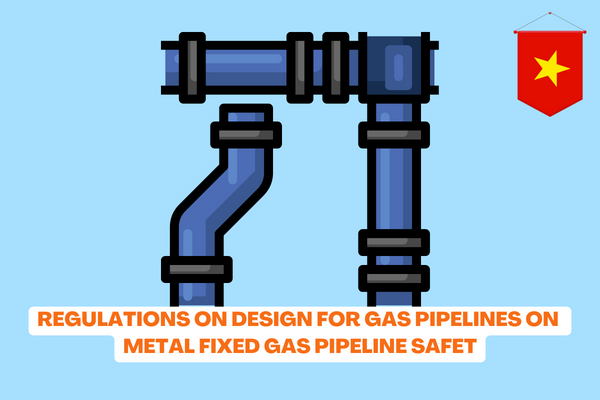Vietnam: Proposing regulations on design for gas pipelines on metal fixed gas pipeline safety?
Are there any proposed general requirements for gas pipelines in Vietnam?
According to the proposal in Section 2.1 Section 2 of the Regulation promulgated together with the Draft Circular promulgating the Vietnam National Technical Regulation on Loaded Metal Fixed Gas Pipelines, the general requirements for gas pipelines are as follows:
Gas pipelines must meet the minimum technical requirements specified in ASME Standard B31.8:2020.

Vietnam: Proposing regulations on design for gas pipelines on metal fixed gas pipeline safety?
What is the proposed regulation of gas pipeline classification in Vietnam?
According to the proposal in Section 2.2, Section 2 of the Regulation promulgated together with the Draft Circular promulgating the Vietnam National Technical Regulation on Loaded Metal Fixed Gas Pipelines, the classification of gas pipelines according to the following standards:
(1) Classification by location level
- Location Level 1: Any section 1.6 km long with less than 10 houses (or equivalent) located within 0.2 km from the outer edge of each side of the pipeline or less than 06 houses per unit area.
- Location Level 2: Any section 1.6 km long with from 10 houses to less than 46 houses within 0.2 km from the outer edge of each side of the pipeline or from 06 to 28 houses per unit area base.
- Location Level 3: Any section of 1.6 km with 46 or more houses within 0.2 km from the outer edge on each side of the pipeline or more than 28 houses per unit area, except for location level 4.
- Location level 4: Includes an area with many multi-storey buildings, dense traffic, and many underground works.
(2) Classification by pressure class
- Level 1: From 0.7 MPa to less than 1.9 MPa.
- Level 2: from 1.9 MPa to less than 6 MPa.
- Level 3: Equal to or greater than 6 MPa.
What is the proposed design regulation for gas pipelines in Vietnam?
According to the proposal in Section 2.4 Section 2 of the Regulation promulgated together with the Draft Circular promulgating the Vietnam National Technical Regulation on Loaded Metal Fixed Gas Pipelines, the design regulations for gas pipelines are as follows:
(1) General requirements
- The design unit must comply with the provisions of this Regulation and applicable standards when designing pipelines. The design unit is responsible for the design dossier.
- Metal fixed gas pipelines are designed according to the conditions of pressure, temperature, working medium and take into account other impact forces (load, expansion, kinetics, wind, earthquake, vibration...) under the most extreme conditions.
- The number and location of valves on the metal fixed gas pipeline system must meet technological requirements, facilitate operation and safety in repair and maintenance.
In addition to the general requirements, when designing gas pipelines according to the Vietnam National Technical Regulation on Fixed Metal Gas Pipelines, the design regulations for gas pipelines should ensure the requirements of:
(2) Pipe wall thickness;
- When calculating the choice of pipe wall thickness, the designer should take into account:
+ The reduction in thickness due to pipe bending at the positions of bent elbows, pipe threading for threaded connecting pipes.
+ The corrosion and abrasion of pipes.
+ Weld strength coefficient.
+ Location level for gas pipelines.
- The formula for calculating the minimum thickness of pipe walls shall be selected by the designer according to applicable standards, which must ensure the working and testing conditions of the pipeline.
(3) Pipeline connection;
- Use edge armor welding when connecting pipes.
- Flanged connection is allowed when connecting pipes to valves and parts of flanged equipment provided that safety is ensured.
- Threaded joints shall not be used for fixed underground laying pipes, except for auxiliary equipment joints (stagnant discharge, valve body discharge and measuring instrument connection) directly into the fittings.
(4) Insulation wrap;
(5) Thermal expansion compensation;
(6) From;
Valves used for metal fixed gas pipeline systems must meet technical requirements suitable for the system.
(7) Rack and mounting system;
The structure of supports or mounts must withstand loads filled with media, insulation, other impact forces and ensure displacement when the pipeline expands.
(8) Stagnant discharge and gas discharge;
- All liquid discharge points of technological pipelines used for operation must be fitted with valves and valves must have blind flanges or plugs (applicable to open discharge).
- The number and design location of exhaust gas valves must ensure safety and the ability to discharge all air on the system when necessary
(9) And requirements for corrosion resistance.
Gas pipelines
a) For underground buried gas pipelines, if the pipeline materials cannot be proved to be corrosion-resistant to the surrounding environment, the pipelines must be protected against corrosion by protective coatings and cathodic protection.
b) In the case of using anti-corrosion coatings, the coating shall be selected in accordance with the pipeline as well as compatible with pipe joint wrapping and repair wrapping. The choice of coating must consider transportation factors, storage, installation conditions, moisture permeability, pipeline operating temperature, environment (including characteristics of soil in contact with pipe sheath), adhesion characteristics and insulation strength.
...
Thus, according to the above proposal, the design for gas pipelines in terms of metal fixed gas pipeline safety must meet the above requirements.
LawNet